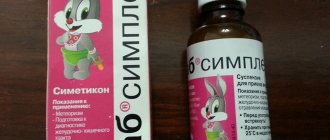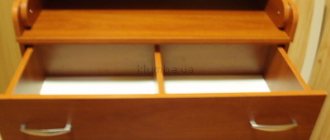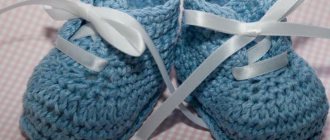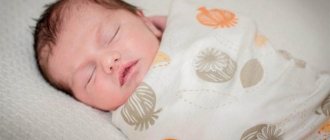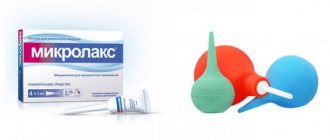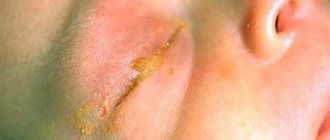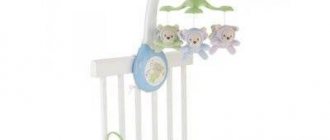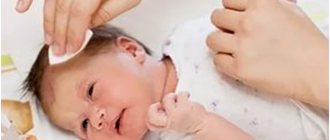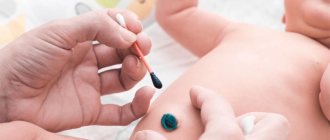Just 15-20 years ago, no one here knew about the existence of disposable diapers. It was something on the level of fantasy. Instead of such a curiosity, our mothers and grandmothers used a reusable diaper made of cloth or gauze. The modern analogue, of course, is much more convenient to use, but a cloth diaper also has its advantages.
What is a reusable diaper made from?
Most often, young mothers hear from older relatives and experienced friends about gauze diapers. Gauze
absorbs moisture well, “breathes”, is available (sold in pharmacies very inexpensively) and only becomes softer after many washes. However, this material has its drawbacks - if you wash several pieces of raw gauze in a regular washing machine, then separating them later and turning them into diapers can be a difficult task.
You can purchase special muslin rags
for diapers, with processed edges and a tighter weave.
Muslin is the same gauze, but with a slightly different weave. Pros - you don’t need to cut pieces of gauze yourself or think about processing the edges, everything is already ready. The downside is the high cost of such flaps, significantly higher than the price of a roll of regular gauze. According to reviews from many mothers, the ideal solution could be scraps of cotton fabric from old bedding
.
They are quite dense, soft after many washes and absorb well. In addition, their edges do not need to be processed, since the fabric itself is usually dense and does not unravel. If you don’t have suitable old sheets and duvet covers in your household, ask your mother and grandmother, they probably have something to share. Also, a reusable diaper can be folded from a regular diaper, preferably not a new thin cotton one
. As an additional liner, you can put a piece of an old, many times washed terry or “waffle” towel inside the diaper.
Baby swaddling technique
We fold the diapers into a scarf
So, we prepared gauze diapers with our own hands. How to make a “kerchief”? To do this, a piece of gauze/diaper must first be folded in half twice: first straight and then diagonally. We place the baby on the scarf, and pass the free lower end between the legs. Then you need to make a “belt” from the side ends: either tie them, or tuck them in, or use Velcro to fasten them.
Roll it into a rectangle
How to make a rectangular diaper? Fold the gauze piece several times to form a 20x60 rectangular shape. Tuck the top edge (the one under the back), lay the baby down and pass the free edge between the legs. Next, the diaper can be tied with a string or secured with a belt. You can also wear waterproof pants on top.
Rolling up in Hungarian
The Hungarian method of swaddling is somewhat similar to the “kerchief”. How to do it?
- Fold the cut in half with the fold down.
- Fold the resulting rectangle to make a square.
- The upper edge of the square must be bent upward to form a scarf.
- Now the resulting form should be turned over.
- We seal the middle of the structure.
What to do next? We place the baby with his butt on the compacted center and pass the free end between the legs. Now all that remains is to put the side ends on top of each other and tie the “belt”. You can make ties from the free ends, or you can secure them with Velcro.
How to make a reusable gauze diaper - watch the video
We decided on the material and chose the size.
Now we take the future diaper and begin to learn how to fold it. Watch the video several times and try to repeat “this trick.” 1. Fold the diaper in half so that you get a rectangle with the wide part facing you, with the fold facing you.
2. Take the upper left (farthest from you) edge of the diaper - one top layer. And pull it to the right edge. In this case, the lower (closest to you) left corner extends to the middle of the upper edge. You should end up with a triangle with the top facing you and the base away from you.
3.Take the triangle by the base and turn it over to the other side. Now the triangle lies with its apex closer to you, and in the middle we see a supply of fabric. We carefully fold this “tail” in the middle of the triangle. This will be the most absorbent part of the diaper. If necessary, we also add additional fabric here, folding it into a long strip.
Ready! Actually, the reusable diaper is ready. It is convenient to hang diapers after washing by folding them in half. Once you remove the dry cloth from the line, it's easy to make a diaper right away. Once you have folded the diapers, roll them up as if you were wrapping a baby. It is convenient to store ready-made diapers in a folded form, in a pile somewhere near the changing table. For example, on the shelf above the changing pad. This way they will always be at hand.
With your own hands
Homemade diapers can be made for both disposable and reusable use. The first is a square or triangular piece of gauze, which, like factory diapers, is wrapped between the baby’s legs. Reusable is made of fabric, more dense in its composition, from natural cotton material. Replaceable gauze diapers are placed inside the panties. Such models are washed a couple of times a day, and disposable ones must be washed immediately after a single use.
So before you make a diaper, you need to think about how you plan to use it.
A disposable diaper is made from cotton fabric, similar to gauze, but denser. Let's look at its production step by step.
- We take a piece of fabric in the form of a square, with sides of 80 cm. For hemming, you can take a piece a couple of cm larger. We overcast or stitch the edges of the fabric on a sewing machine, then fold the square in half. Place the fabric on the table with the fold down.
- We take the upper edge of the fabric cut with our hand on the right, and the lower edge on the left, then carefully pull the upper edge to the right, and move the lower edge to the middle of the top line, thus constructing a triangle. We turn the triangle on the reverse side and fold it towards the center. There should be a slight overlap of fabric in the central part of the diaper. You can then stitch the resulting seal to the base, saving a lot of time on folding the fabric in future use.
- To put on this diaper, you need to place the resulting scarf at an angle downwards, lay the baby down and place the lower edge of the scarf on his tummy. Then we take the remaining ends from the side and twist them inward, trying not to create discomfort in the baby’s tummy area. You can add Velcro to the edges to make it easier to secure the diaper.
Making a reusable diaper yourself is also not difficult, since the technique can be used the same as for making disposable diapers from gauze. You can change the method. The difference is the use of denser fabric; fabric from previously used bedding is perfect here, as it will be soft enough for the baby’s delicate skin. Soft cotton material, chintz or calico are also used.
When making reusable products using the method described above, we do everything the same, only we use thick fabric. This method is not recommended for newborns due to the density of the fabric and the inconvenience of putting on panties, but if we install Velcro, they will become more comfortable. In the center, a kind of pocket is sewn inside using waterproof material (soft oilcloth), thereby preventing possible leakage.
Then we make gauze pads; they will require replacement after each soaking. It is recommended to prepare 10-15 such liners. We fold the gauze so that we get about five layers and sew it on the sides. Our reusable diapers are almost ready. The final touch will be attaching buttons to the sides of the product. The sides of the diapers will be securely fastened and will not come unfastened during the baby’s active movements.
The next method of making a diaper can be used by folding the diaper into a scarf. Take a piece of fabric 90 cm by 90 cm. Fold the fabric straight, then lay it diagonally. We lay the baby down and pass the free end between the baby’s legs. We make a belt from the ends on the sides by tying the ends of the fabric into small knots. You can also use Velcro. So we can highlight the following advantages of using reusable gauze diapers:
- gauze will protect the child’s skin from irritation and chafing, and it is worth highlighting its environmental friendliness;
- since the inserts are changed frequently, feces do not come into contact with the baby’s sensitive skin, the sterility of the product is ensured;
- saving money;
- does not require much labor to manufacture, folding and sewing such products is quite simple, and the material can always be found at hand;
- there are no excessive flavorings in the gauze;
- gauze products are environmentally friendly.
Until disposable diapers were invented, there were no other options: in a family where a child was expected, gauze diapers for the newborn were made in advance with their own hands. This was the first clothing for a baby at the beginning of life.
Now gauze diapers are increasingly giving way to disposable diapers and are considered a legacy of antiquity. But don’t immediately discard the option of gauze diapers.
How to put a diaper on a baby
Very simple. Take the ready-made diaper, unfold its “wings” and place the baby in the middle of the triangle so that the liner strip is between the baby’s legs. Fold the bottom edge of the triangle up, between the baby’s legs. Then take one of the “wings” of the diaper and wrap it around the top, around the baby’s waist. Make sure there are no unnecessary folds on the back. Repeat the same with the second “wing”, securing the edge inside the diaper from above.
Now it would be nice to secure this entire structure with something
. There are several options:
- On top of a gauze diaper put on pants or rompers
. At the same time, you need to understand that most likely these sliders will also be wet after peeing. An additional liner may partially prevent your clothes from getting wet, but this cannot be guaranteed.
- If your home is warm enough and even hot, you don’t want to wear extra pants, you can attach a gauze diaper, buttoning the bodysuit over it
. It is better if the bodysuit is a little big so that the baby does not feel too tight. Keep in mind that the likelihood of side leaks increases.
- If you need the structure to definitely not get wet, then the most convenient and comfortable option for the child is to wear woolen changing pants on top of a gauze diaper
.
(see video at the bottom of the page) They are usually included in sets of ecological changing systems, but they can easily be purchased separately, knitted yourself from high-quality soft wool, or even cut from an old sweater. The water-repellent properties of natural wool are enough to prevent everything around you from getting wet after peeing. To make these pants get even less wet, they are washed with a special shampoo with lanolin
. You can also buy simply purified lanolin at the pharmacy and treat your panties as needed.
You can also try securing the gauze diaper with a safe baby pin or special clips
(from changing systems) or put on special waterproof panties on top, choosing them according to size.
In this video clip you can see again how to fold a gauze diaper, how to put it on your baby and how to secure it.
Advantages and disadvantages
The only advantage of diapers made with your own hands from gauze is their availability. It is enough to once buy a large piece of gauze, cut it into pieces (20-25 pieces will be required) and use until the child grows up. Among the disadvantages of gauze diapers:
- Frequent washing required. A set of 25 “panties” for a newborn is enough for a maximum of 2 days.
- Anxiety for baby and mother. Wet diapers cause discomfort and baby crying. They must be changed immediately so that the baby does not experience skin irritation.
- Lack of proper sleep. After peeing in his sleep, the baby will definitely wake up and cry. And if during the day the baby can still sleep peacefully for at least an hour and a half, then the whole family can forget about a good night’s rest.
- Inability to go for long walks. Normally, a child pees once every 1.5-2 hours. Mom will have to stay close to home to quickly return and change the baby’s clothes. Or reduce walks to a minimum.
How many reusable gauze diapers do you need?
The answer depends on how often you use them. On average, if you use disposable diapers for sleep and walking, you will need no more than 10 pieces of gauze per day
.
Taking into account daily washing and drying, prepare approximately 15-20 pieces. Accordingly, the number of gauze diapers required for a newborn increases
if you practically do not use disposable diapers, and
decreases
if you practice
drop-off
(what is this? Read more here).
It must be remembered that gauze diapers must be removed immediately
after a “wet activity” or bowel movement to avoid skin irritation.
After stool, the child must be washed. We do not recommend using wet wipes instead of cleaning, as many children are allergic to the chemicals in the wipes. Instead, if necessary, you can use regular cotton pads soaked in clean water. Just as effective and simple. At the same time, you can ventilate your baby’s bottom for an additional 5 minutes. If irritation occurs, diaper cream with zinc oxide and fresh air will help. To prevent diaper rash, often leave your baby to lie down without a diaper on a waterproof diaper.
Dimensions
Depending on the age of the child, the size of gauze diapers for newborns varies.
So, the length and width of the gauze should be as follows:
- For a newborn baby 60/100 cm.
- For infants 1-3 months 80/100 cm.
- For children from 3 months 180/90 cm, if the diaper is made using the “kerchief” technique.
- For children from 3 months 60/100 cm, if the “rectangle” technique is selected.
- For babies from 3 months 90/90 cm, if the “Hungarian” technique is taken as a basis.
The proposed sizes of gauze diapers can be modified individually depending on the child’s body type, including the size of a gauze diaper for a newborn.
How to wash gauze diapers?
It is convenient to immediately soak used gauze diapers in a container of water. This can be a basin or a special bucket for soaking in the bathroom; if desired, you can add a couple of drops of potassium permanganate solution or a little washing powder to the water. At the end of the day , ask dad
Throw the contents of the bucket into the washing machine.
You can and should wash gauze and other cotton reusable diapers
.
Use temperatures above 60 degrees and additional rinsing to ensure the cleanliness and quality of the diaper, especially if there are any problems with the baby’s skin or stool. It is not at all necessary to iron both diapers and just the diapers and clothes of a healthy baby, especially on both sides. But if someone close to you insists, don’t interfere,
because everyone can help the young mother in the way they think is right.
Features of application
In order for gauze diapers for newborns to last longer, they must be properly cared for. Helpful tips for care and use:
- It is imperative to apply a protective cream under the products, because gauze cannot remain dry when wet. Contact of urine with skin causes irritation, so diaper dermatitis may develop.
- After each removal of the product, the child must be washed.
- Newborns pee often - every 20-30 minutes. Products should be changed immediately after getting wet. If the fabric is even slightly wet, it must be replaced, otherwise the newborn's sensitive skin will suffer.
- The gauze should be rinsed with warm water, and if there is feces, washed at a temperature above 90 degrees with soap or a special powder for infants. Dried gauze is ironed at maximum temperature.
- It is better not to use gauze products at night - you will have to change them often, which will disturb the sleep of the baby and mother. It is also not advisable to wear a gauze diaper for a walk or during a visit to the clinic.
Why do you need all this trouble?
Using reusable gauze diapers not only helps you save money, but also seriously reduces the amount of non-degradable waste in the world your baby will live in. You can be confident in the quality of the diapers you make
, not impregnated with synthetic gels and unknown chemicals.
After each wetness, you replace the reusable diaper with a new, clean and dry one
, teaching your child to be neat. Therefore, the baby quickly develops an idea of the cause-and-effect relationship “pee - wet - changed - dry,” which is unrealistic with the constant use of super-absorbent disposable diapers. According to the experience of many mothers, when using reusable diapers, babies quickly learn to “tolerate” little by little and pee less often at night.
When using reusable gauze diapers, only natural cotton fabric comes into contact with the baby's skin
which allows the skin to breathe.
A disposable diaper also “breathes,” but only until the first wetness. After this, a plastic-paper “toilet” filled with liquid gel and left on the child’s skin turns into a kind of unhealthy compress. Due to the fact that disposable diapers are not cheap, not all mothers will immediately replace the expensive “12 hour dry” diaper after the first wetness, especially at night. By using reusable gauze diapers and changing them immediately, you are providing your baby with better care and better hygiene
.
What to choose for the maternity hospital?
Previously, in maternity hospitals they only dreamed of mother and child staying together. The children were kept in a general ward, separate from their mothers. Before feeding the newborn (like any mother of a newborn, it is probably important for you to learn everything about the correct attachment of the baby to the breast >>>) they unwrapped it and examined whether it was clean. Wrapped in a sterile thin diaper.
Important!
I recommend washing all clothes for newborn babies (except diapers) in advance, ironing both sides, tying them in a clean diaper, and putting them in a bag intended for the maternity hospital.
Of course, you are not happy about the fact that you will need to wash, dry and iron gauze diapers every day. I can suggest a middle ground: it is better for the baby to wear a diaper at night and during walks. It is advisable to use gauze products the rest of the time. Many women today have chosen this economical combined approach to caring for newborns. Perhaps it will be acceptable for you too?
What's the result?
As we can see, make a reusable gauze diaper
It’s not difficult, it’s quite simple and convenient to use.
Any mother can at least partially replace disposable “diapers” and “huggies” with gauze and cotton diapers. And the best thing is that, if necessary and desired, you can always choose
what to put on your newborn right now: a disposable or reusable diaper. Or even leave it to ventilate on a waterproof cotton sheet. Our grandmothers and mothers practically did not have this choice, but we do. So let's take advantage of this by choosing the best for your baby!
What types of homemade diapers are there?
There are two types of diapers for children. They can be done in a few minutes:
- for disposable use - such diapers have a square or triangular shape, are wrapped around the baby’s body, and look like a store-bought product;
- for reusable use - it is fashionable to make them from natural fabric with an oilcloth pocket and a fabric liner.
Both options are easy to sew with your own hands, but the first gauze diapers need to be changed and washed often (we recommend reading:). Reusable fleece or gauze diapers will only require replacing the insert, which will significantly save your time and effort.

